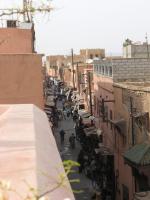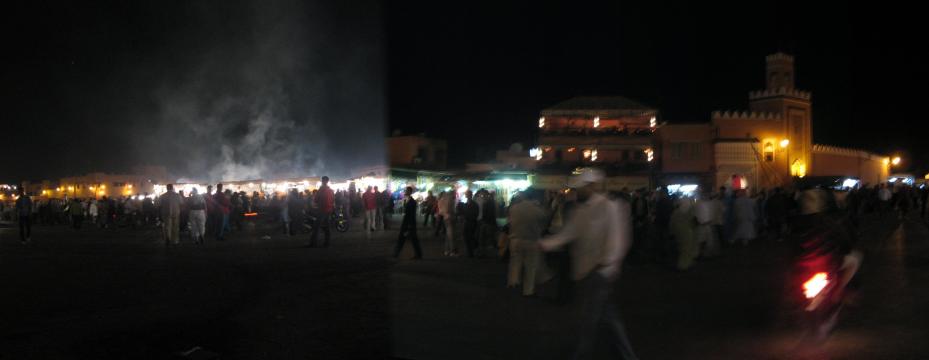
Marrakech is really two cities - the one inside the medina and the one outside.
Outside the medina you will find international hotels, shops, offices and McDonalds but it's all a bit characterless. Apart from a few clues you could be in any big city almost anywhere in the world.
It is inside and around the medina you will find the real essence of Marrakech.
My first impression was the traffic. Cars, busses, horse taxis, donkey and mule carts, bikes, scooters and pedestrians all vying for the same inadequate space on the roads. There's a general suggestion that you drive on the right but in practice if you see a spare piece of tarmac anywhere, go for it.
Crossing the road is an experience in itself. Life is too short to wait for a proper gap so you just wait until the bustle is slow enough and step out. As you cross, you make your own mobile clearing as traffic passes either side of you until, hopefully, you reach the other side.
 |
| Storks on a minaret |
Cast your gaze upwards and you will notice balls of sticks adorning every available tall spire, such as the mosque towers. Watch for a moment and a stork's head is likely to appear. These majestic birds seem to have taken over the city. Particularly at dawn and dusk they sweep through the air low over the buildings, looking strangely like pterodactyls.
The other big impression is rubbish everywhere. If you get up up to the top of, say, a riad and look down on it all you will see piles of discarded bicycle tires and other detritus of civilisation heaped into every available space (particularly on roofs) which is not being used for anything else.
 |
| Rue Riad Zitoun El Kedim Leading to Djeema El Fnaa |
The innermost part of the medina doesn't really comprise roads - more alleyways, but that doesn't stop the mopeds and donkey carts driving down them, often at alarming speed. The alleys are lined with tall buildings, they interconnect and entwine and are often very similar. It is therefore easy for the visitor rapidly to get disoriented and lost. The locals play on this fact. Stop for so much as a minute to take stock of your surroundings and you are likely to get immediate offers of assistance and directions. Say no, though, unless you really are in difficulties. You are not seen as a lost soul. You are a potential source of money for services rendered. If you aren't in any difficulty the locals may invent one for you, telling you for example that the way you are going is closed. It isn't. This is just a ploy
Within the medina I found a hand held GPS useful. I had preloaded it with a map of the main alleyways courtesy of Google Earth. The big problem was the souks (markets). These have roofs so you soon lose GPS reception. The best bet is to keep walking in a straight line. Usually this will bring you out into the open (eventually) and then you can pause, fending off another half dozen offers of assistance, until the GPS gets a fix again. By this tactic I never got completely lost although it sometimes felt like it.
Using the GPS and remembering a few significant landmarks I was able to navigate my way around the medina without too much difficulty. Even when lost, though, I never felt threatened in this city. Hassled yes but threatened no.
The focal centre of the medina is the Djeema El Fna - the big square. Actually it's more triangular than square with a bottom edge running EW and coming to a point at the North.
Even by day this is bustling with activity but it's at night that it comes alive. Centre stage is a large area where you can eat food cooked out in the street. It's impossible to tell whether it's one large eatery or lots of small ones joined together, probably the latter. The air above the white tarpaulins is filled with the steam of the many open air kitchens.

Djeema El Fnaa at night
Around the food servery there are numbered stalls. Most common are those selling freshly squeezed fruit juice for a few Dirham a glass - although it's probably best not to think too hard about how clean the glasses are, and the stalls selling dried fruit and nuts. They didn't strike me as particularly cheap at around 120 Dirham for a kilo of, say, cashews.
The South West corner of the Djeema seems to be the entertainments area with ethnic musicians, dancers, fortune tellers and snake charmers. Expect to pay about 20 Dirham to take a photo of any of these. First time around I threw a 10 Dirham coin in the hat. The man carefully fished it out and peered at it with suspicion, then at me, like I'd tossed in a dead rat. The hat was proffered again. A second 10 Dirham coin and he was all smiles and I was an old friend again. Don't begrudge it. This is their income. I just didn't know what the going rate was first time around.
There are restaurants all around the Djeema, many with balconies overlooking the whole spectacle. You pays your money and you takes your choice. There's a small place on a corner (no balcony) near the South East end where a tagine can be had for around 60 Dirham. I was never able to try it because it was always packed. I guess that means it must be good.
At the other end of the scale there's the Marrakshi, to the East of the Northern corner. The entrance is just off the square but it has first floor windows overlooking proceedings. It is cool salubrious and charges European prices. Expect to pay more like 160 Dirham for a tagine. Alcoholic drinks are available.
For a mid range meal, try the restaurant with a balcony which is practically at the Northern extreme of the square. Unfortunately I forget the name but we ate their a couple of times and got a reasonable meal without spending a fortune.
The medina is a world of secret doors. If you've booked a riad and your taxi driver takes you off into a dark alleyway, don't assume the worst. You walk down a seeming dead end and stop at an often unimposing metal door in the wall. You knock anxiously. Someone opens the door and you step through a portal into a different world.
 |
| Courtyard of the riad Dar Anika The pool is off to the right |
Inside the riad the bustle of Marrakech is suddenly a thousand miles away. You are taken into a tiled courtyard, often with a small bathing pool. Your host ushers you into a room extravagantly furnished with low sofas and soft cushions and brings you a tray of mint tea.
The bedrooms line the balconies (probably three floors) overlooking the courtyard. For the most part the windows face inwards, such light as there is coming through the open roof of the courtyard. Thick stone walls muffle the sounds of the medina outside.
There are other types of secret doors too. To the south of the medina, just off the Place des Ferblantiers you will find La Tanjia. The exterior is understated and the only hint of the hidden pleasures within is the bouncer on the door. Inside you are swept into another different world. Downstairs is the bar and upstairs the restaurant. The clientelle are all Europeans, probably on account of the prices. You may find a small Berber trio playing traditional music to entertain the customers. You will be offered an aperitif. This is one of the few places in Marrakech which serves alcohol - at a price. I suspect this is the main reason for the bouncer. A beer is around 60 Dirham a small bottle, wine more.
The food is good. A little pricey by Moroccan standards though not by European ones. For a one course meal of tagine expect to pay 160 Dirham. An excellent three course set meal for two persons can be had for 500 Dirham. There were 10 dishes in our starter alone. The price will climb rapidly if you take wine with your meal.
Half way through our dinner the Berber trio stopped and exotic music started to emanate from speakers round the restaurant. The doors opened and a troupe of belly dancers came in - one for each area of the restaurant. Money was stuffed into brassieres. Slightly tipsy middle aged men made fools of themselves dancing with the girls and wiggling their hips. But it was all (just about) done in the best possible taste.
As we walked back to our riad, slightly bemused, Jenny asked "did that really happen?"
Sometimes Marrakech really does seem like a dream.
| Back | All text and images Copyright © Keith Sheppard, 2008 |